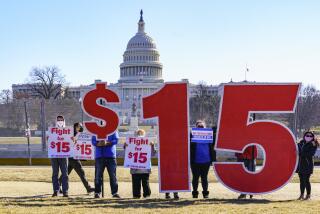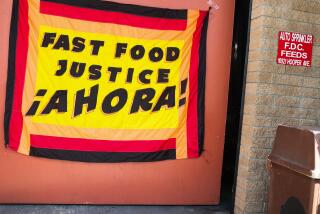Fast-food workers across U.S. rally for $15 hourly pay
LOS ANGELES and NEW YORK — In the aftermath of the recession, hundreds of workers in low-wage industries have tried to call attention to how difficult it is to survive on the minimum wage.
Thursday might have been their biggest effort yet.
Fast-food workers in an estimated 60 cities protested outside 1,000 stores, turning out at the crack of dawn to call for union representation and a wage of $15 an hour. Organizers of the effort, bankrolled largely by the SEIU and promoted by a slew of community groups, said it was the largest protest ever to hit the fast-food industry.
“The economy is doing poorly. Everything is expensive. With high taxes, we’re not going to be able to pay rent,” said Domino’s worker Francisco Zuniga, 34, who brought his 3-year old son, David, to a Hollywood protest.
The South Los Angeles resident said he can’t support his family on $8 hourly pay from his pizza-making, order-taking and delivery job at Domino’s. His bosses won’t give him full-time hours because of looming healthcare law changes — “they don’t want to pay for the insurance,” he said. His rent is $850 a month, utilities are $100 and other costs spring up unexpectedly.
Teenagers used to dominate fast-food jobs. Now, many older workers, out of a job because of the stagnant economy, have gravitated toward the industry. They’re ripe for organizing because they’ve seen the economy improve around them while their pay has remained the same and they continue to work without benefits.
This is good news for the SEIU and other labor groups, which have faced years of declining membership. Unions are finding that fast-food workers are all too happy to protest, figuring that their jobs are bad enough that if they lose them from protesting, they haven’t lost much.
“Marx said, ‘Workers of the world unite, you have nothing to lose but your chains,’ and when it comes to fast-food workers, they really have nothing to lose,” said Nelson Lichtenstein, a UC Santa Barbara labor expert. “There’s no career prospects from a fast-food restaurant, high turnover, unpredictable hours.”
The marches, happening just before Labor Day, extended to Atlanta, Boston, Chicago, Dallas, Detroit, Las Vegas and many other urban centers. California was a hotbed of protests, with events in Berkeley, Fremont, Oakland, San Diego and elsewhere.
But the impetus for fast-food change originated in New York, when hundreds of workers and supporters banded together in late November to picket quick-service giants. Thursday’s protests marked the fourth round of minimum wage rallies in the city.
Derrick Langley, 27, of Brooklyn, has burns on his arms and legs from a fryer at the KFC where he works. The lanky man, who towered over the crowds of protesters on Fifth Ave in Manhattan, showed the scars to news crews while complaining about the way his managers treat him.
“There’s not just one, not just two, not just three reasons I’m out here today,” he said. “I’m out here taking a stand for all the fast-food workers around the world.”
It’s a sentiment echoed by Tamara Green, 26, of Brooklyn, a Burger King worker who said she makes $7.25 an hour and works 19 hours “on a good week.”
“These strikes and these movements, they’re not just for us. They’re for another generation of those who won’t be able to survive in this economy.”
The National Restaurant Assn. argues that many employees are young part-timers who aren’t responsible for their own households.
But Arne L. Kalleberg, a sociology professor at the University of North Carolina at Chapel Hill, said the median age for fast-food workers is more than 28; for women it’s 32. And low-wage jobs are among the fastest-growing in the country, he said.
“These protests are a cry for help,” he said. “It’s a microcosm of a larger phenomenon. It reflects the growing frustration of these folks who have for a long time seen the gap between what they’re earning and the tons of money the corporations and the CEOs are making.”
Tilesha Rice, 36, was at a protest in South Los Angeles. The mother of four works at a Burger King, and says she can barely pay her bills.
“I don’t want to be homeless with my kids in the streets,” she said. “I thank God I have a job to help me and my family, but every check that I get I just pay rent. I don’t have money left over to pay for my kids’ school clothes or nothing.”
Companies such as McDonald’s have recently stood behind their pay practices. At Burger King, more than 99% of all U.S. restaurants are owned by franchisees, who control wage decisions for employees, the company said in a statement.
Workers in the system receive compensation and benefits “that are consistent” with the quick-service industry, according to the statement.
The National Retail Federation called Thursday’s protests a “publicity stunt” in a statement, saying that they’re “just further proof that the labor movement is not only facing depleted membership rolls, they have abdicated their role in an honest and rational discussion about the American workforce.”
Looking ahead, Brent Giddens, managing partner in the Los Angeles office of employment and labor law firm Carothers DiSante & Freudenberger, said he’s skeptical of protesters’ chances of success.
“I can’t see the federal minimum wage rising to anywhere near $15 an hour,” said Giddens, whose firm’s clients have included Taco Bell and Jack in the Box. “It would have a devastating effect on the economy and can only have the effect of driving labor out of the country.”
However, Giddens said he “would not at all be surprised” to see a minimum wage increase in California, where the lowest legal hourly pay is $8.
“The political climate here is very favorable toward employees and historically always has been,” he said. “Nobody can argue that California is not among the most protective of employee rights among all the states.”
Amina Hall hopes it stays that way. The high school senior, protesting in South L.A., said she wanted a raise from her current $8-an-hour pay at the store so she could help her jobless mother support her large family while also padding her college tuition fund. The 17-year-old works part-time, mostly as a cashier, but doesn’t see a future in the gig.
“It’s not something I want to do long-term,” said Hall, who dreams of becoming a criminal justice attorney. “I want to make a career for myself.”
Twitter: @tiffhsulatimes, @alanasemuels
Hsu reported from Los Angeles and Semuels from New York.
More to Read
Inside the business of entertainment
The Wide Shot brings you news, analysis and insights on everything from streaming wars to production — and what it all means for the future.
You may occasionally receive promotional content from the Los Angeles Times.












